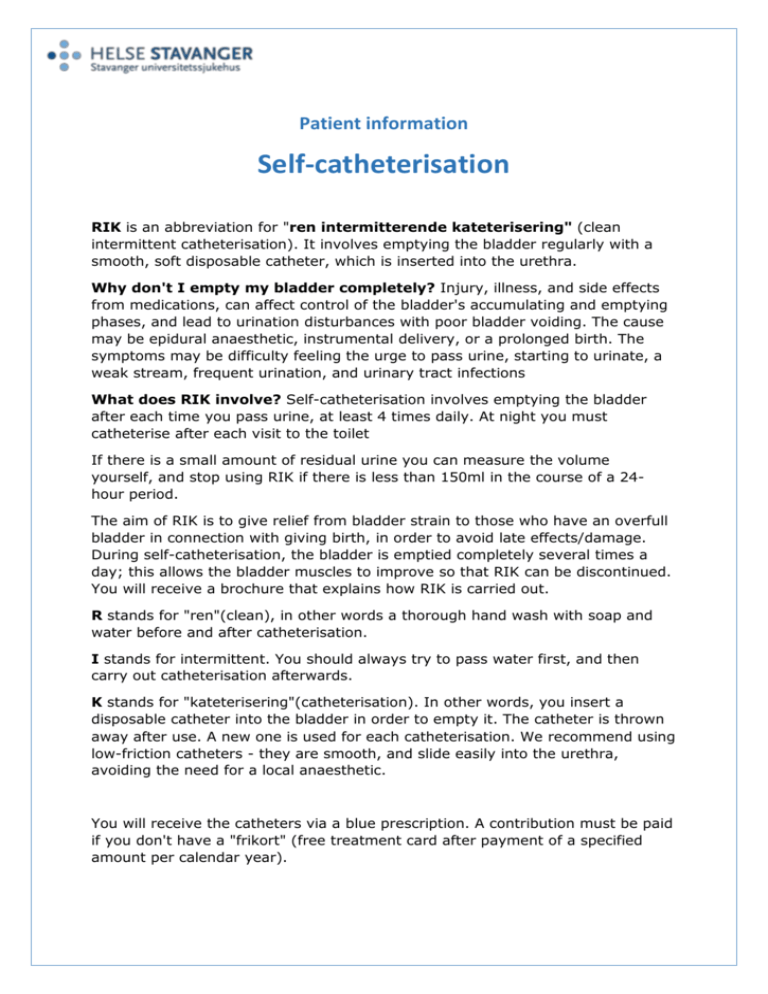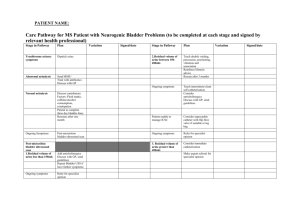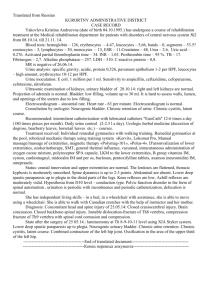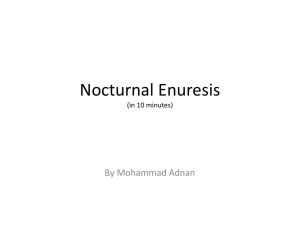RIK is an abbreviation for "ren intermitterende kateterisering" (clean
advertisement

Patient information Self-catheterisation RIK is an abbreviation for "ren intermitterende kateterisering" (clean intermittent catheterisation). It involves emptying the bladder regularly with a smooth, soft disposable catheter, which is inserted into the urethra. Why don't I empty my bladder completely? Injury, illness, and side effects from medications, can affect control of the bladder's accumulating and emptying phases, and lead to urination disturbances with poor bladder voiding. The cause may be epidural anaesthetic, instrumental delivery, or a prolonged birth. The symptoms may be difficulty feeling the urge to pass urine, starting to urinate, a weak stream, frequent urination, and urinary tract infections What does RIK involve? Self-catheterisation involves emptying the bladder after each time you pass urine, at least 4 times daily. At night you must catheterise after each visit to the toilet If there is a small amount of residual urine you can measure the volume yourself, and stop using RIK if there is less than 150ml in the course of a 24hour period. The aim of RIK is to give relief from bladder strain to those who have an overfull bladder in connection with giving birth, in order to avoid late effects/damage. During self-catheterisation, the bladder is emptied completely several times a day; this allows the bladder muscles to improve so that RIK can be discontinued. You will receive a brochure that explains how RIK is carried out. R stands for "ren"(clean), in other words a thorough hand wash with soap and water before and after catheterisation. I stands for intermittent. You should always try to pass water first, and then carry out catheterisation afterwards. K stands for "kateterisering"(catheterisation). In other words, you insert a disposable catheter into the bladder in order to empty it. The catheter is thrown away after use. A new one is used for each catheterisation. We recommend using low-friction catheters - they are smooth, and slide easily into the urethra, avoiding the need for a local anaesthetic. You will receive the catheters via a blue prescription. A contribution must be paid if you don't have a "frikort" (free treatment card after payment of a specified amount per calendar year). Follow-up The midwife will call you the day after training to see how it is going. Some master RIK from day one, while others may need more guidance, either by 'phone or during a new hospital appointment. Most say that it goes smoothly after some trial and error. It is important that you feel confident about this treatment. A follow-up appointment at the Gynaecological Outpatient's Clinic (one week after discharge); Date………………………. Time…………………… (If discharged during a weekend you will receive a 'phone call from the Gynaecological Outpatient's Clinic about your appointment If there are any signs of a urinary tract infection, we recommend that you submit a morning urine sample to your GP/General Doctor. Signs of infection: stinging when passing water, ill-smelling urine, pain... When there is little residual urine, you can monitor the volume yourself, and stop self-catheterising when there is less than 150ml over a 24-hour period. You must still attend the agreed appointment for measurement of residual urine before the follow up is discontinued. If you have any questions please call the Maternity ward: 7G tel: 51518778/ 7I tel: 51513289 The Women`s Clinic Stavanger University Hospital Kvinneklinikken SUS, desember 2014. www.sus.no/kvinneklinkken











